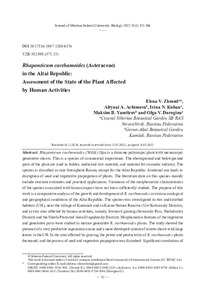Rhaponticum carthamoides (Asteraceae) в Республике Алтай: оценка состояния при антропогенном воздействии
Скачать файл:
URI (для ссылок/цитирований):
https://elib.sfu-kras.ru/handle/2311/145496Автор:
Жмудь, Е. В.
Ачимова, А. А.
Кубан, И. Н.
Ямтыров, М. Б.
Дорогина, О. В.
Zhmud, Elena V.
Achimova, Altynai A.
Kuban, Irina N.
Yamtirov, Maksim B.
Dorogina, Olga V.
Дата:
2022-03Журнал:
Журнал Сибирского федерального университета.Биология. Journal of Siberian Federal University.Biology, 2022 15 (1)Аннотация:
Rhaponticum carthamoides (Willd.) Iljin – корневищное поликарпическое растение
с монокарпическими генеративными побегами, ресурсный вид комплексного типа использования,
у которого надземная и подземная части используются в качестве кормового и лекарственного
сырья и в косметической промышленности. Вид отнесен к редким на всей территории России,
кроме Республики Алтай. Нерациональное использование приводит к нарушению семенного
и вегетативного возобновления растений. Основные исследования, касающиеся данного вида,
посвящены ресурсным оценкам и практическому применению. Изменчивость морфометрических
характеристик вида при антропогенном воздействии изучена недостаточно. Цель работы – сравнительный анализ особенностей роста и развития R. carthamoides в различных эколого-географических
условиях Республики Алтай: в ненарушенных местообитаниях (НМ) (Усть-Коксинский
район, окр. с. Кайтанак и Катунский заповедник) и в условиях антропогенного
воздействия (АВ) (Шебалинский район, Семинский перевал и Онгудайский район, ООПТ
«Шавлинский»). Изучение морфометрических признаков вегетативной и генеративной сферы
проведено в ценопопуляциях у зрелых генеративных особей R. сarthamoides. Обнаружено, что
особи вида в НМ характеризовались мощной зоной возобновления с более развитой системой
розеточных побегов и крупными листьями. В местах с наличием АВ у R. carthamoides выявлено
снижение мощности и продуктивности особей, нарушен процесс семенного и вегетативного
возобновления. Изучение корреляционных связей признаков показало, что к признакам,
детерминирующим стабильность особей в НМ, относятся диаметр надземной части растений,
связанное с ним число вегетативных розеточных побегов (r=0,75), размер их листьев (r=0,55)
и длина генеративного побега (0,63). Адаптация у особей вида в условиях АВ сопровождалась
дезинтеграцией параметров роста и развития, снижением фотосинтетической поверхности
и уменьшением емкости зоны возобновления, что впоследствии может привести к нарушению
ценотической роли вида вплоть до его выпадения из травостоя Rhaponticum carthamoides (Willd.) Iljin is a rhizome polycarpic plant with monocarpic generative shoots. This is a species of commercial importance. The aboveground and belowground parts of the plant are used as fodder, medicinal raw material, and material for cosmetic industry. The species is classified as rare throughout Russia, except for the Altai Republic. Irrational use leads to disruption of seed and vegetative propagation of plants. The literature data on this species mainly include resource estimates and practical applications. Variations of the morphometric characteristics of the species associated with human impact have not been sufficiently studied. The purpose of this work is a comparative analysis of the growth and development of R. carthamoides in various ecological and geographical conditions of the Altai Republic. The species was investigated in two undisturbed habitats (UH), near the village of Kaitanak and in Katun Nature Reserve (Ust-Koksinsky District), and in two sites affected by human activities, namely, livestock grazing (Seminsky Pass, Shebalinsky District) and the Shavla Protected Area (Ongudaysky District). Morphometric features of the vegetative and generative parts were studied in mature generative R. carthamoides plants. The study showed the presence of a very productive regeneration zone and a more developed system of rosette shoots with large leaves in the UH. In the sites affected by grazing, the power and productivity of R. carthamoides plants decreased, and the process of seed and vegetative propagation was disturbed. Significant correlations of features were found in the UH. The diameter of the aboveground part of plants is related to the number
of vegetative rosette shoots, the size of their leaves, and the height of generative shoots (r = 0.75; 0.55;
0.63). These parameters determine the stability of individuals of the species. Adaptation of the plants in
the sites affected by human activities was accompanied by the disintegration of growth and development
characteristics. We revealed a decrease in the photosynthetic surface area and a reduction in the capacity
of the regeneration zone. This process can lead to an impairment in the function of the species in the
ecosystem and even its disappearance from the grass stand

